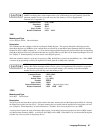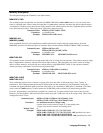
Language Dictionary 67
The Agilent SAS uses nonvolatile memory for recording register states. Programs that repeatedly use
*SAV for recalling states cause frequent write cycles to the memory and can eventually exceed the
maximum number of write cycles and may cause the memory to fail (see Supplemental
Characteristics in appendix A).
Command Syntax *SAV <NRf>
Parameters 0|1|2|3
Example SAV 3
Query Syntax (None)
Related Commands *RCL *RST
*SRE
Meaning and Type
Service Request Enable Device Interface
Description
This command sets the condition of the Service Request Enable Register. This register determines which bits from the
Status Byte Register (see *STB for its bit configuration) are allowed to set the Master Status Summary (MSS) bit and the
Request for Service (RQS) summary bit. A 1 in any Service Request Enable Register bit position enables the corresponding
Status Byte Register bit and all such enabled bits then are logically ORed to cause Bit 6 of the Status Byte Register to be set.
See "Chapter 4 - Status Reporting" for more details concerning this process.
When the controller conducts a serial poll in response to SRQ, the RQS bit is cleared, but the MSS bit is not. When *SRE
is cleared (by programming it with 0), the Agilent SAS cannot generate an SRQ to the controller.
If PSC is programmed to 0, the *SRE register bits are stored in nonvolatile memory. The nonvolatile
memory has a finite maximum number of write cycles (see Supplemental Characteristics in appendix
A). Programs that repeatedly write to nonvolatile memory can eventually exceed the maximum
number of write cycles and may cause the memory to fail.
Command Syntax *SRE <NRf>
Parameters 0-to 255
Default Value (See *PSC)
Example *SRE 20
Query Syntax *SRE?
Returned Parameters <NR1> (Register binary value)
Related Commands *ESE *ESR *PSC
*STB?
Meaning and Type
Status Byte Device Status
Description
This query reads the Status Byte register, which contains the status summary bits and the Output Queue MAV bit. Reading
the Status Byte register does not clear it. The input summary bits are cleared when the appropriate event registers are read
(see "Chapter 4 - Status Reporting" for more information). The MAV bit is cleared at power on or by *CLS.
A serial poll also returns the value of the Status Byte register, except that bit 6 returns a Request for Service (RQS) instead
of a Master Status Summary (MSS). A serial poll clears RQS, but not MSS. When MSS is set, it indicates that the Agilent
SAS has one or more reasons for requesting service.


















